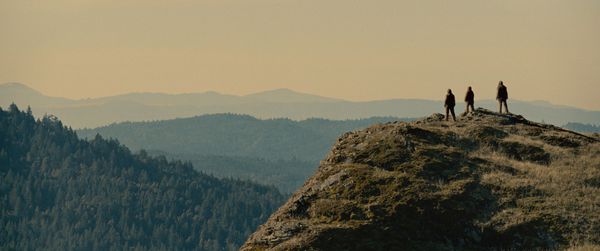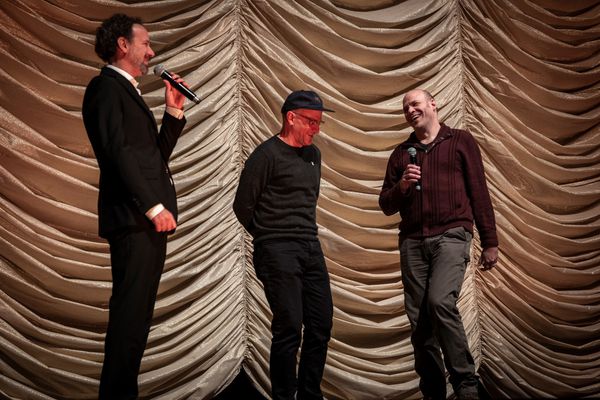The enduring myth of Bigfoot gets an often funny and surprisingly poignant consideration in Sasquatch Sunset, the latest offbeat tale from brothers David and Nathan Zellner. Although you’ll be hard pushed to recognise them beneath the fur and prosthetics, this wordless comedy stars Jesse Eisenberg and Riley Keough alongside Nathan Zellner and Christophe Zajac-Denek as a troop of sasquatches.
The film premiered at Sundance in January, before having its international bow in Berlin this week.
David Zellner, who wrote as well as co-directed the movie with his sibling, says: “We've always loved Bigfoot since we were kids.”
He says that they became interested in what became known as the Patterson-Gimlin film, from the late Sixties, which purports to show a sasquatch in the wild.
He adds: “That is the template for the mythology in America. And it's just basically the famous pose, where it's giving a sideways glance. We were just obsessed with that as kids. I think maybe it's partly that America is so young and it doesn't have centuries of folklore like other countries do, so America kind of gloms onto Bigfoot in terms of our mythical creatures. And we've always just been obsessed with that.”
The brothers also had a fascination with the way that different countries across the globe had similar sorts of ‘man in the woods’ myths, and David says that thinking about what else the sasquatches might be doing “started as a joke”. The pair of them have tackled the subject before in short film Sasquatch Birth Journal 2 but here it gets treated to a full world-building exercise. Shot in northern California, where the most “sightings” of Bigfoot have been recorded, Sasquatch Sunset follows a year in the life of this tragicomic clan, including unexpected encounters with evidence of humans.
“If it's like any other animal, it's doing every good and bad thing an animal is doing,” David adds. “And so that led us to approach it almost from an anthropological perspective. Just treating it instead of as a mythical creature, as though it was an animal. Both the humour and the poignancy for us came in the kind of uncomfortable grey area between human and animal behaviour, where there’s an awkward overlap.”
If there’s one thing the brothers have proved good at down the years it is creating worlds that are immersive, even when they verge on the absurd. In Kid-Thing, for example, we’re asked to buy into a young girl finding a woman in a hole - and with Sasquatch Sunset, the pair deliver on an even bigger scale.
Nathan agrees it is something they’re interested in but adds: “I think that's a good point. I don't think it's conscious. But I think it is something that we always kind of get drawn to it - taking fantastical ideas or odd things and grounding them in realism and giving them a natural quality. And, you're right, this is a really good example of that, because it is this mythical creature, but we treat it as though it really exists. And the way we filmed it was very naturalistic.”
David adds: “Everything we do is pretty intuitive. But if I step back and look at it, we like the idea of taking absurd things and normalising them and vice versa. Through that, creating the world is part of the challenge, too, but just taking something that's very absurd, and trying to legitimise it to hopefully get people along for the ride. Because we're taking these mythical creatures and costumes, we wanted to put them in an environment that was as naturalistic as possible. There were no sets, we shot on location in very remote areas - these old growth redwood forests that were 1000s of years old. And then we wanted real animals juxtaposed against the sasquatches to legitimise them. Also there's something very absurd about putting real animals with them and also how the real animals didn't care.”
“The elk are just there,” adds Nathan. “And the looks that they gave us were just kind of nonchalant. They didn't really care.”
When it came to the casting, everyone had to get on the same wavelength because the sasquatches only communicate in grunts, meaning this is a silent film of sorts.
David says: “The script was only about 60 pages long, which is like half the length of a normal script, but there's no dialogue in the script, it's very detailed scene descriptions about their emotional state, almost written more like prose, I guess. In the rehearsal process, we had a movement coach that Jesse brought in, we worked with, to get a kind of a uniformity in their, their physicality, and, and, and vocalisations. We knew we wanted professional actors, not stunt people, because the challenge for us all along was having the more absurd, slapstick elements, but we wanted it to have a certain poignancy, so that hopefully you uncomfortably find yourself emotionally invested.”
Speaking about suiting up for the role, Nathan says it took about two hours. He adds: “They were very heavy, but I feel like each of us had a similar experience of, once you get that suit on, it was really easy to get into character. We would have a lunch break, and the only way you could feed yourself was to eat like the sasquatch. We weren't method, we were just kind of in the moment with these suits.”
David says that while Nathan was perfect for the role, they weren’t sure about being able to get the others involved.
He adds: “Jesse is an old friend of ours but we were still nervous when we sent it to him how he would react. But it's the kind of project where either you get it or you don't and if you get it you're all in. Both Jesse and Riley, to their credit, weren't turned off by it. There's going to be a vanity aspect, ‘What you're not going to see me, I'm not going to talk?’ But they saw how liberating it was, and that they wouldn't get an opportunity like this again.They were very excited. They both said yes right away. And I remember Riley telling us, ‘I want to be the most feral of the bunch’.”
Speaking about the mixture of poignancy and slapstick, David says it was a “tricky dance” to establish and maintain but says they didn’t want to “approach anything with a wink or be condescending towards the material”.
He adds: “We wanted to kind of pull people in with more sketchy, absurd, almost slapstick aspects of it, which was fun to do because you could never do those things with humans. It was the closest we’d get to trying a silent, Buster Keaton type film. But then we wanted it to kind of almost be a sneak attack as you try to add moments of resonance and depth. And then before you know it, you're hopefully caring about them more and its meaning more than just a series of sketches. But that was the challenge. It's ultimately intuitive. But I think everything we do is a mix of humour and pathos. It's just been just an intuitive process and just kind of going with what feels more truthful in the moment in writing it and then in the execution.”
The brothers then talked about a specific Eighties pop tune that is used at a key point in the film and the spoiler averse, may want to skip this portion of the feature until after they have seen the film. It comes at a key moment in the film where the more poignant elements of it really start to kick in.
“We like the idea of being poignant and absurd at the same time when we can, there's something perverse about that to us. I love that song. When it came out, like 30 years ago, I remember thinking, ‘I would love to put that in the movie’, but didn't know where and it was filed away. And then when we're writing this it was like, ‘Oh, there's no other song’.”
The song in question is Erasure’s Love To Hate You.
“It's something about the progression of it. It’s very poppy, and lively and then it has this progression that builds steadily up to the chorus. It just felt to have this escalation would be funny. And then we wanted something really simplistic lyrically, where it's just like love and hate. So we got lucky and were able to get it. I don't know what we would have done if we couldn't get it.”
Speaking about the creatures’ encounters with human activity, including logging markings, a road and a campsite, David says that they tried to approach it from an animal’s perspective rather than a human’s.
“We tried to strip it down to the most simple kind of forms that would be unsettling to the creatures. So like a road - this line cut through the wilderness - seemed like it would be the most shocking thing. A surface they've never felt before. We had a lot of fun exploring how they explored things with their senses in a different way than humans. I mean,there's more smelling in this movie. And a lot of the tactile quality of how surfaces feel to them because they weren't communicating through language, it was communicating through touch and smell and things like that.”
He says they also picked a strong colour palette for the human objects, “the brightest colours that would not occur in nature”.
He adds: “The nice thing was that with something mythical like this is you can kind of create your own rules. The look and design was kind of based on what people were familiar with in terms of how Bigfoot looked, so we pulled from Bigfoot lore, when it fit into the story, but we didn't feel bound to it, we could kind of make our own rules.”
Both brothers say they still love the idea of the mystery surrounding the creatures and that they would love them to genuinely exist.
Nathan says: “I want to believe and I really do enjoy talking to Bigfoot experts and people who truly believe and just seeing their passion. Anytime anybody's passionate about something, it's very interesting. I'm excited to show this to more of those people just to hear what they take away from it, because I think we did a good job of research and doing our own version of the different traits that are known to them.”
When it comes to the experience of watching the film, David says they “want audiences to feel something but we don’t want to tell them what to feel”.
He adds: “Even if someone had a strong negative response, that’s valid. I mean, we'd rather they like it… What we really enjoy with everything we've done is when people come up to us afterwards and say, ‘I think the film is about this’, and then the person next to them will say, ‘I think it's about this’ and sometimes it'd be completely opposite but they're both valid. And that, to me, is so much more interesting than if we were imposing, ‘This is exactly what it is’. My favorite art in general is art that leaves breathing room for the audience to bring your own thing. You feel respected more and then it becomes bigger than you.
Recalling that someone told him they were moved to tears by scenes involving a baby sasquatch, Nathan agrees: “I would say it's open to interpretation. Something that we wanted to achieve was to humanise something that you wouldn't expect to have that kind of connection to. And that's not going to be something that everyone connects to in the same way but to hear that it has affected people is a nice compliment.”
Sasquatch Sunset will be released in the US by Bleeker Street on April 12























